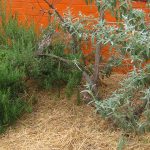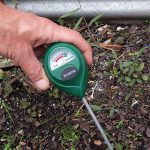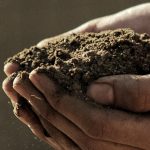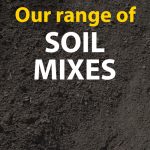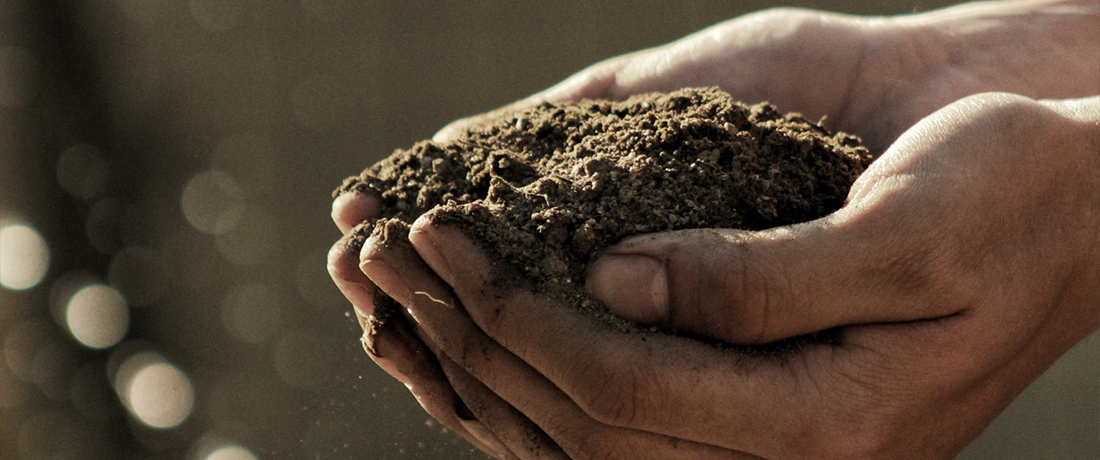
Soil… most people just think of it as dirt, something to grow a few plants in, and maybe something to play in when you are young. However, (healthy) soil is a living, breathing organism, vital for the health and well-being of our precious plants out in the garden. And just as we feed and nurture our plants, so must we feed and nurture our soils. But what determines a healthy soil, how do we achieve it, and how will it benefit us as gardeners?
What is a healthy soil?
Firstly, lets’ talk about what soil actually is. Technically, it is the thin layer of material that covers the earths crust, providing plants with support, mineral nutrients, water and air.
Soil is derived from the weathering and breaking down of parent material (rocks), with the addition of varying types and levels of organic matter supplied by the break down and decomposition of plant and animal material. The amount and type of organic matter in the soil, coupled with the original parent material, determines the structure, nutrient content and behaviour of the soil. All very important factors to understand when planting out a garden.
Most Australian gardeners are presented with quite poor soils as a result of housing and urban development, overworking, previous chemical practices, poor watering practices and so on. But, as we know, the most important factor in a healthy garden is healthy soil. This basically means that your plants can only be as good as the soil they grow in. If you have an exhausted soil with no nutrients your plants will struggle and may starve to death. If you have light sandy soil your plants may not get enough moisture and will probably die of thirst. If you have heavy clay soil your plants will not get enough drainage and will probably drown!
Good soil is full of life, and it needs some of the same things which animals and plants need to survive… like air, water and nutrients. We can not easily see all the activity going in the soil but we can smell it and feel it to get a sense of its health. Healthy soil smells sweet. It’s loose, well drained and rich in organic matter. Air and water move freely through the soil because air space exists around soil.
Healthy soil will have about:
- 24% air
- 25% water
- 45% minerals
- 3 – 5% humus (the dark organic material that is the end product of composting)
- up to 1% living organisms
But what if your soil is not healthy and your plants are not performing? Fear not, we have the answer!
How can I make my soil healthier?
To have lovely healthy plants, you need healthy soil, and to have healthy soil you need the following important ingredients:
- Compost
- Moisture
- Mulch
- Good drainage
Organic Matter?
Organic matter is anything that contains carbon compounds that were formed by living organisms. It consists of dead and decaying forms (mainly plants and manures), living plants (mostly roots) and living micro-organisms and soil animals
Why do we care?
Because nutrients taken up by plants in the natural environment (this excludes commercial agriculture) are derived largely from the decomposition process of soil organic matter It is easy (and cheap!) to make your own compost. If using your own chicken or farm manures, it is a good idea to run it through your compost system where the heat of the composting process will destroy most weed seeds. Fresh chicken manure is too ‘hot’ to use directly in the soil and should always be composted before use.
Confusion?
Humus, compost and organic matter are often incorrectly used interchangeably. Humus and compost are different, but both are components of organic matter.

Humus
Humus is organic matter that is decomposed to the point where it resists further decomposition and is stable and accumulating in the soil. It is mostly extremely stable carbon compounds with no phosphorus or nitrogen. The stable form makes it difficult to break down by microorganisms.
Why do we care?
Nitrates (NO3-) stay in solution between the soil particles and are readily leached from the soil. Humus has a positive charge and aids in holding the negatively charged nitrates in the soil profile, making them available for plants to take up.
Humus has extremely high absorption abilities. It can hold and release water and nutrients as needed. It also improves the physical structure of soil so that it is crumbly and aerated.
Confusion?
‘Humus’ is often incorrectly used instead of the term ‘compost’. Compost is able to be broken down in the soil releasing nutrients for plants, unlike humus.
All types of soil benefit from the addition of compost, as the presence of organic material in the soil introduces microbes and worms which break down the compost. And as we all know, worms are the gardener’s best friend! They are so industrious in decomposing dead and decaying organic material that in a short period of time their activity can greatly improve any soil type. Worms are not limited to just decomposing organic material, they greatly increase the microbial activity within the soil, mix and aggregate the soil, provide paths for fine roots to grow along, and increase both water filtration and water holding capacity.
The water retention in light, sandy soil can be greatly increased with the addition of organic materials and bentonite clay. This in turn creates an ideal environment in which the worms will thrive. As the compost breaks down nutrients are released into the soil, also creating a food source for your plants. So this simple process dramatically improves light soil in two very important ways, providing a long term remedy to these problems.
Even heavy clay can be greatly improved by the addition of compost. Don’t break your back trying to dig up heavy clay. Just add a generous layer of compost on top of the soil, cover with lots of lucerne, pea straw, or fine mulch, and then go and do something else in your garden! Give the area an occasional watering during hot weather, otherwise leave it to the rain to keep the area moist. After a few months you will find an enormous amount of worm activity has taken place, which will have broken up the clay, improved the texture of the soil, and subsequently improved the drainage too.
Producing your own compost is really easy. For further information on making your own compost, check out this page.
Other materials that can be incorporated into the composting process include animal manures, which will introduce valuable microbes into your compost ‘micro climate’. Indeed it is much wiser to use these in your compost recipe, so that by the time you apply the compost to your garden the manure is well rotted. Fresh manure should never be applied directly around plants, as it will burn the roots and severely stress your plants. One very important thing to remember is to avoid obtaining horse manure from racing stables, because if the horses have been treated with antibiotics and worming treatments then the manure will not contain the desirable microbes needed for healthy composting. This can even result in the subsequent death of your plants as there are no ‘good’ microbes in the soil! Make a point of getting your aged manures from only natural, organic sources.
Worm farms are also an excellent idea, offering a convenient alternative to compost bins if you don’t have much space in your garden. This is another way to provide your garden with important nutrients and organic materials, and a very easy way to ensure you have plenty of worm activity to help improve your soil quality.
Moisture and Mulch
It’s almost impossible not to mention these two topics in the same breath! A great deal has already been written about both, but it is still worth remembering that mulch is the most effective way to keep moisture in your soil. You can choose from a wide range of mulch materials, but remember that it is very important to apply a generous deep layer of mulch. Don’t be tempted to spread it too thin. If your garden provides you with lots of prunings throughout the year, invest in a shredder and make your own supply of mulch to add to your garden – the ultimate in garden recycling! Mulching also acts to suppress weeds, keep soil temperature stable and stimulate microbial activity, meaning less work for gardeners. Mulching should be considered an on-going soil conditioning process, and is as essential in the garden as pruning and weeding.
Hydrophobic soils are soils which have dried out and become water repellent to the point where water beads up and runs off the surface. Water is no longer retained in the soil and plants become highly water stressed. It will occur more easily in sandy soils and in soils with high organic content. The best way to fix this problem is to use a soil wetting agent (not water storing granules – they are a different product for a different purpose). This will often need to be applied more than once, and once the soil appears to be wetting correctly, give it a good deep soak and do not let it dry out again. If possible add in highly composted organic matter, either dug in or as a mulch. This will aid microbial activity and that too is beneficial to soil health.
Good Drainage
Whatever your soil type, good drainage is essential for healthy plants. Of course, if you have light sandy soil, the drainage is probably too good! This is where the use of compost will greatly reduce rapid moisture loss, and improve the soil’s capacity to retain water, which is really important in these times of water restrictions. Heavy soils also benefit from this process, but some gardens may need more work than others! If you have a brand new house and a bare block of land which only offers compacted clay and subsoil, don’t lose heart; compost can help!
Don’t be tempted to plant straight into compacted clay, as very few plants are tough enough to handle it. Compacted fine clay particles don’t allow water to drain away, so winter rains will cause the roots of plants to rot, and the hot summer sun bakes the clay as hard as concrete! Adding compost and mulching will help improve this soil, allowing water retention and drainage as the organic matter breaks down and mixes with the heavy clay soils.
In addition to a composting and mulching routine, some people opt to import new topsoil into their gardens. The best type of topsoil is a dark sandy loam, rich in organic matter to hold moisture but with enough coarse particles to allow good drainage. So if you need to buy topsoil, this is a very good investment. An important tip when establishing new garden beds is to avoid compaction of the topsoil before planting, although it is important to rake the soil evenly to ensure removal of air pockets. The soil will settle naturally, especially after watering, so you may even find it necessary to ‘top up’ the levels with extra soil after a few days.
Don’t forget to add compost to the soil regularly to encourage lots of worm activity and guarantee excellent drainage!
But why is this so important?
Under the current climatic (and political) conditions, it is unlikely we will ever live in a time without water restrictions again. And why should we? By developing water wise gardens and adopting water capture and re-use behaviours such as rainwater and greywater usage, the need to irrigate our gardens with drinking quality water is a thing of the past. While plant choice and groupings, environmental conditions and garden micro-climates are all important aspects of a water sensitive garden, a healthy soil is the most important feature of a sustainable, water wise garden.
Healthy soils with high organic matter content require less water, little to no additional fertiliser and are less likely to change structure and performance during long-term irrigation with greywater. Plants in healthy soils will be more vigorous, robust, and less prone to attack from pests and diseases, saving gardeners time and money. In turn, the environment is spared the damaging affects of prolonged fertiliser and pesticide usage… a great result for us, and future generations.
Improving Soils
It can be very tempting to look at the soil you have and think it is better to replace it with soil you can buy in. It looks all fresh and new, problem free and feels like a clean slate. Ignoring the environmental aspects of digging up soil, dumping it, creating new soil, relocating it etc, there is a good chance you are better off improving the soil you have rather than replacing it. Better off in that you will have both a superior soil and more money in your pocket.
Many soils you buy are constructed soils, so they are relatively uniform from one batch to the next. These soils can have no, or minimal, clay component, which is a problem in the medium to long term. Click here to see how to improve these soils. Often deplored by gardeners, clay has many highly superior qualities and plays a vital role in good soil. You will end up with a beautiful rich dark fruitcake of a soil if you improve your existing clay based soil.
When discussing soil improvement, the first step is appreciating the benefits and essential nature of organic matter. No matter which literature source you access, whether peer reviewed journals, university fact sheets or garden blogs, it is impossible to escape the vital role organic matter plays in the soil.
For Australian soils adding organic matter is almost always extremely beneficial. Add in both compost and manures, spread out over the top and then dig in to around a spade depth. Do not over work the soil and try to work when soil is damp – not dry and not wet. The addition of organic matter allows the build up of worms, soil arthropods and soil micro-organisms; these decompose the organic material and in the process provide nutrients for plant uptake.
Very occasionally (almost never) an enthusiast will add in far too much organic matter resulting in salt build up, large nitrogen release, excessive phosphorus and an imbalance of other minerals. This is rarely a problem in Australia.
Keeping the soil moist – to a level of a wrung out sponge – is important in keeping the soil micro-organisms alive, and these are vital for good plant health. Mulch is very beneficial in improving soil moisture and adding organic material to the soil. As the soil micro-organisms break organic matter down and drag it into the soil, it needs to be replaced periodically. If the organic matter is not replaced, the soil micro-organisms will die and soil fertility will fall.
If you have resorted to importing soil it is important to avoid ‘textural interfaces’. This is where you have one type of soil laid directly over another type of soil; the resulting difference in pore spaces interferes with soil water movement and root development. Make a transition layer between the soils, mixing the fill (imported soil) with the soil underneath.
Improving Soils in Established Gardens
Soils in established gardens can become very undernourished over time unless careful maintenance is used. The loss of organic matter by the continual tidying and removal of leaves and prunings leaves the soil hungry and depleted with minimal worm and micro-organism activity. When major soil amendment is not possible because of existing roots of trees, shrubs, perennials and lawns it is still possibly to make significant improvements in the soil.
With the exception of fungi, nearly all soil micro-organisms and worms need a moist environment to operate successfully in. If soils have dried out and become hydrophobic then you will need to treat that first. Keep soils moist and spread manures over the top – no more than 5cm thick, and allow the soil fauna to drag the manures into the soil. Once manure has disappeared, can repeat manure application or use a pea or lucerne straw mulch. This will add organic material as well as keeping soil moisture at good levels for the worms and soil micro-organisms to operate effectively. If available, spreading liquid worm waste from worm farms is greatly beneficial.
For a more concentrated fertilizer ‘hit’, use the pelleted form of manure based fertiliser and sprinkle over the soil before spreading mulch. It can also be used when mulch is topped up. Controlled release fertilizers can also be used in conjunction with mulch, these will aid plant growth, but do little to improve your soil directly. However, increased root growth assists many soil micro-organisms as they live in the rhizosphere (area immediately adjacent to and on the roots).
Minimise soil compaction using organic mulch and managing foot traffic. Compacted soil loses the essential pore space for gas exchanges and for water to move through. Soil compaction is much more rapidly done and serious when the soil is wet. Avoid walking on wet soils where possible and use thick mulch on paths to reduce impact of foot traffic.
A commercial aerator (either a corer or a spiked roller), can be used to aerate soils without causing too much damage to plant roots. After aeration, spread manures or compost over and rake through.

